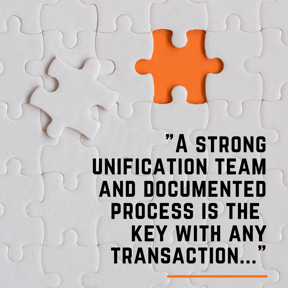The Importance of Post-Acquisition Integration
The adrenaline rush you get when closing on an acquisition (or merger) is exhilarating.
Excitement builds as you make the formal announcement to the team and send the press release. The congratulations start pouring in and all the endorphins rush in. If only this were the punctuation at the end of the sentence. It’s more like a new chapter that is yet to be written.
Enjoy your post close rush, but know that success is in what follows, not the successful completion of the acquisition.
Often, business leaders are not prepared for this next phase in the transaction, which happens to be the most difficult. Integration, or as we prefer to say, unification, is the next and most important phase. Closing the deal is now a success that lives in the past and future success is properly unifying the teams and driving the intended benefits.
I speak from experience. 
Our firm has completed multiple acquisitions over the last few years and there were many mistakes. I wildly underestimated the time and process necessary for a good unification plan. I presumed all of the details were flushed out during our due diligence prior to close.
WOW, was I wrong!
I’ve learned that the unification process is the number one key success factor for any deal. Not purchase price, term deals, structure, etc.
We must execute on unifying the two organizations by having a detailed process and dedicated team to see it through.
Change is hard! Showing respect and being sensitive to the new team members is critical. It is important to share your excitement and the upside to the unification, but it is just as important to clearly communicate that it will be difficult initially and you don’t expect this transition to be easy. Your transparency and empathy will go a long way. They will respect your honesty and understanding.
Our Experience
Immediately after one of our acquisitions, which happened to fall just before our “busy season,” I walked into a conference room and started with…
“Welcome to Brixey and Meyer, you are going to experience a lot of change, it will be challenging, and this will probably be the worst busy season you have ever had…any questions?”
I certainly got some odd looks and a few searching for the nearest exit. There, I took the opportunity to explain that we are in this together and our success follows their success in becoming a part of our team. We understand they didn’t’ choose to come work with our firm in the traditional sense. So we were there to listen to their concerns. Sharing that we have a dedicated unification team and together our priority is to make this as smooth as possible was very important. After a few weeks I received feedback from the new team members. Sharing the reality and setting expectations ahead of time that it would not be “rainbows and unicorns,” brought a sense of comfort and trust.
Building a Unification Team
Most companies have a due diligence team in place during the acquisition process. This team focuses on everything from creating the LOI to closing the deal. However, few organizations have a formal unification team in place once the deal is closed. In my experience, this is critical.
Our Unification Team includes team members from both organizations and we meet weekly for the first quarter after an acquisition. We include these groups:
- CEO/President (Yes it is that Important!)
- HR
- Finance
- Operations
- Marketing
Topics the unification team regularly communicates:
- Strategic Plan of your organization
- How each team member impacts the strategic plan
- Importance of culture and what that means in your organization
- Internal processes that drive your organization forward
- Community involvement, market presence & brand awareness
- Pricing & value proposition of product/services
A strong unification team and documented process is the key with any transaction.
Investing your time and energy supporting and communicating with the new team members post transaction will ensure a smoother transition and payoff long term. Your team members will be happier, more satisfied and the result will be greater performance! Isn’t that the reason we did the transaction in the first place?
As you continue to grow, both organically and thru acquisitions, please feel free to contact me to talk through your mistakes and success stories. And if you would like to hear more about our unification team or process, leave a comment below for our team to setup a call.
Additional content by Doug Meyer:
BLOG: "Work On Your Business Not In Your Business" ... But HOW?
BLOG: 10 Steps to Consider When Evaluating Your Succession Plan
BLOG: Why Phantom Stock Can Help You Recruit and Retain Key Employees
PODCAST: The Secrets to Successful Succession Planning with Ohio Society of CPAs

.png)